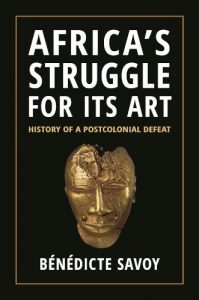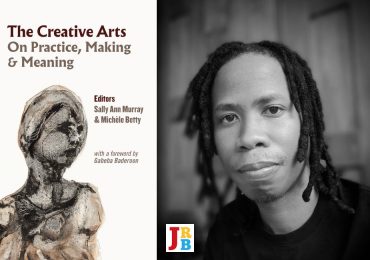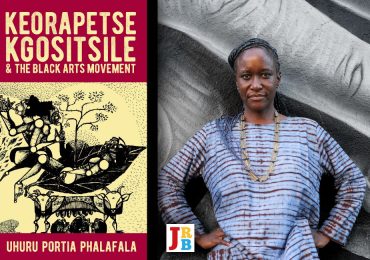The JRB presents an excerpt from Africa’s Struggle for Its Art: History of a Postcolonial Defeat by Bénédicte Savoy.

Africa’s Struggle for Its Art: History of a Postcolonial Defeat
Bénédicte Savoy (trans. Susanne Meyer-Abich)
Princeton University Press, 2022
Preface
Almost all of Africa’s ancient artistic heritage is now preserved in European countries: in the United Kingdom, France, Germany, the Netherlands, Vienna and Belgium. It is difficult to convey the magnitude of this reality in numbers, to physically experience the space it occupies, to imagine the weight it represents, the forces it took to move these pieces and the time it would take to physically lift them one by one. The British Museum alone has sixty-nine thousand objects in its inventory from African countries south of the Sahara. The Weltmuseum in Vienna has thirty-seven thousand. The Royal Museum for Central Africa in Tervuren, Belgium, has one hundred and eighty thousand. The Nationaal Museum van Wereldculturen in the Netherlands holds sixty-six thousand, the Ethnologisches Museum in Berlin seventy-five thousand, and the Musée du Quai Branly-Jacques Chirac in Paris almost seventy thousand. The major public museums in Paris, Berlin, London, Brussels, Vienna, Amsterdam and Leiden together hold more than half a million African objects.
These figures do not even include European regional, military, university or missionary museums—from Oxford to the Vatican, via Le Havre, Lyon, Stuttgart or Leipzig—which possess several more tens of thousands of objects. Not to mention natural history collections that contain countless botanical, geological and human specimens, prestigious unique specimens taken from Africa: the fossil bones of the largest dinosaur known today, for example, lay for one hundred and fifty million years in the soil of what is now Tanzania before being removed and assembled in Berlin, where they have been on public display since the nineteen-thirties. The same applies to libraries: since the beginning of the twentieth century, to study the manuscript heritage of African countries south of the Sahara required trips to the British Library in London, the Bibliothèque nationale de France in Paris or the Vatican Library in Rome.
Nowhere else in the world, neither in the Americas nor in Asia, nor in Africa especially, have such collections been accumulated. In the United States, the total number of objects from African countries south of the Sahara in the inventories of art and ethnology museums barely reaches fifty thousand pieces in total: about twenty thousand in the Penn Museum in Philadelphia, thirteen thousand in the Department of Anthropology of the Smithsonian Institution in Washington, DC, four thousand in the Brooklyn Museum in New York and only three thousand in the famous African art collection of the Metropolitan Museum in New York. Taken together, American museums hold fewer African objects than the African heritage department of the Musée du Quai Branly-Jacques Chirac alone.
This very particular geographical distribution is inextricably linked to the nineteenth and twentieth centuries occupation of the African continent by European states. It also explains why the first major global debate on restitution of these objects emerged in Europe in the nineteen-seventies. And within Europe, it was certainly in the Federal Republic of Germany (FRG), during this period of the Cold War that the public debate was most intense, most rich in content and most enduring, spanning museums, politics, administrations, media and television. While Germany may not have been a major colonial power in terms of the number of its colonies, its historical development from dozens of monarchies, principalities, bishoprics, duchies and city states—to some extent reflected in its federal government structure today—translated into an unusually varied and rich museum landscape, with competing institutions jockeying for position and influence, often led by ambitious professionals and documented extensively in associated archives.
This book is devoted to the European debate on the restitution of Africa’s cultural heritage in the aftermath of the independence of former colonised countries. Nigeria and the FRG play a central role. In 1976, the Christian Science Monitor called the global debate on restitution a ‘German debate’. But the arguments, speeches and rhetoric of these countries and the political strategies they adopted at the time are precise reflections of those deployed in other countries, for example, in the United Kingdom and France. They were pervasive until very recently, and in some cases even continue to be.
The present book was published in Germany on 18 March 2021. At that moment, and for several years before—despite increasing pressure from the public, scholars and activist organisations, despite the intervention of the Nigerian ambassador to Berlin, Yussuf Tuggar, and despite the historical evidence of archival documents—the management of the Staatliche Museen zu Berlin (Berlin State Museums) still continued to deny any direct involvement in the often violent cultural plunder of African countries, while burying the possibility of restitution under a ubiquitous discourse about the costly and timely exercise of provenance research.
It was also claimed that no African country had ever put forward a restitution request to Germany. It therefore came as a considerable surprise when four days after the German publication of this book, during a press conference on 22 March 2021, the Staatliche Museen zu Berlin administration suggested—in what appeared a well-calculated leak—that Germany was committed to returning the famous Benin bronzes looted by the British army from Benin City, Nigeria, and acquired in large numbers by German museums around 1900. If these restitutions do indeed take place, they will come almost fifty years after Nigeria’s first requests in 1972. They are also expected to have a knock-on effect for other institutions and countries.
The present investigation therefore reconstructs half a century of resistance by European collecting institutions in the face of legitimate demands for restitution from African countries. By taking a long, hard and unflinching look at European museums’ disavowal and arrogance towards these demands we must now be compelled to enter a new era in this history. It is hoped that this book will contribute to this movement.
In this aim, I would like to express my gratitude to my excellent editor, Michelle Komie, and my wonderful translator, Susanne Meyer-Abich, without whose professional support this English edition could not have been realised.
Berlin, July 2021
~~~
Publisher information
For decades, African nations have fought for the return of countless works of art stolen during the colonial era and placed in Western museums. In Africa’s Struggle for Its Art, Bénédicte Savoy brings to light this largely unknown but deeply important history. One of the world’s foremost experts on restitution and cultural heritage, Savoy investigates extensive, previously unpublished sources to reveal that the roots of the struggle extend much further back than prominent recent debates indicate, and that these efforts were covered up by myriad opponents.
Shortly after nineteen-sixty, when eighteen former colonies in Africa gained independence, a movement to pursue repatriation was spearheaded by African intellectual and political classes. Savoy looks at pivotal events, including the watershed speech delivered at the UN General Assembly by Zaire’s president, Mobutu Sese Seko, which started the debate regarding restitution of colonial-era assets and resulted in the first UN resolution on the subject. She examines how German museums tried to withhold information about their inventory and how the British Parliament failed to pass a proposed amendment to the British Museum Act, which protected the country’s collections. Savoy concludes in the mid-nineteen-eighties, when African nations enacted the first laws focusing on the protection of their cultural heritage.
Making the case for why restitution is essential to any future relationship between African countries and the West, Africa’s Struggle for Its Art will shape conversations around these crucial issues for years to come.





